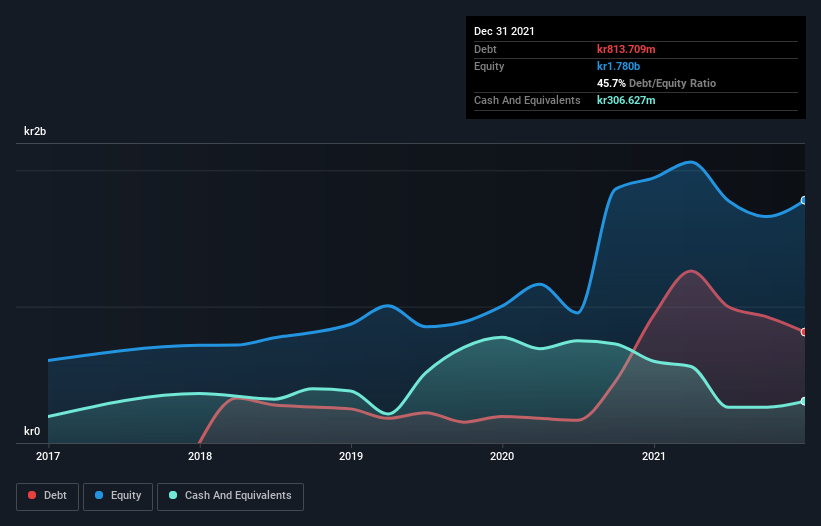
Legendary fund manager Li Lu (who Charlie Munger backed) once said, 'The biggest investment risk is not the volatility of prices, but whether you will suffer a permanent loss of capital.' It's only natural to consider a company's balance sheet when you examine how risky it is, since debt is often involved when a business collapses. As with many other companies Fjordkraft Holding ASA (OB:FKRFT) makes use of debt. But the more important question is: how much risk is that debt creating?
When Is Debt Dangerous?
Debt is a tool to help businesses grow, but if a business is incapable of paying off its lenders, then it exists at their mercy. Ultimately, if the company can't fulfill its legal obligations to repay debt, shareholders could walk away with nothing. However, a more usual (but still expensive) situation is where a company must dilute shareholders at a cheap share price simply to get debt under control. Of course, plenty of companies use debt to fund growth, without any negative consequences. When we think about a company's use of debt, we first look at cash and debt together.
View our latest analysis for Fjordkraft Holding
How Much Debt Does Fjordkraft Holding Carry?
As you can see below, Fjordkraft Holding had kr813.7m of debt at December 2021, down from kr935.9m a year prior. However, because it has a cash reserve of kr306.6m, its net debt is less, at about kr507.1m.

How Strong Is Fjordkraft Holding's Balance Sheet?
We can see from the most recent balance sheet that Fjordkraft Holding had liabilities of kr7.10b falling due within a year, and liabilities of kr1.35b due beyond that. Offsetting these obligations, it had cash of kr306.6m as well as receivables valued at kr5.26b due within 12 months. So its liabilities total kr2.89b more than the combination of its cash and short-term receivables.
This deficit is considerable relative to its market capitalization of kr2.98b, so it does suggest shareholders should keep an eye on Fjordkraft Holding's use of debt. Should its lenders demand that it shore up the balance sheet, shareholders would likely face severe dilution.
We measure a company's debt load relative to its earnings power by looking at its net debt divided by its earnings before interest, tax, depreciation, and amortization (EBITDA) and by calculating how easily its earnings before interest and tax (EBIT) cover its interest expense (interest cover). Thus we consider debt relative to earnings both with and without depreciation and amortization expenses.
Fjordkraft Holding has a low net debt to EBITDA ratio of only 0.73. And its EBIT easily covers its interest expense, being 15.6 times the size. So you could argue it is no more threatened by its debt than an elephant is by a mouse. It is just as well that Fjordkraft Holding's load is not too heavy, because its EBIT was down 30% over the last year. When a company sees its earnings tank, it can sometimes find its relationships with its lenders turn sour. When analysing debt levels, the balance sheet is the obvious place to start. But ultimately the future profitability of the business will decide if Fjordkraft Holding can strengthen its balance sheet over time. So if you want to see what the professionals think, you might find this free report on analyst profit forecasts to be interesting.
Finally, while the tax-man may adore accounting profits, lenders only accept cold hard cash. So we always check how much of that EBIT is translated into free cash flow. During the last three years, Fjordkraft Holding generated free cash flow amounting to a very robust 86% of its EBIT, more than we'd expect. That puts it in a very strong position to pay down debt.
Our View
Fjordkraft Holding's EBIT growth rate was a real negative on this analysis, although the other factors we considered were considerably better. There's no doubt that its ability to to cover its interest expense with its EBIT is pretty flash. It's also worth noting that Fjordkraft Holding is in the Electric Utilities industry, which is often considered to be quite defensive. Looking at all this data makes us feel a little cautious about Fjordkraft Holding's debt levels. While we appreciate debt can enhance returns on equity, we'd suggest that shareholders keep close watch on its debt levels, lest they increase. When analysing debt levels, the balance sheet is the obvious place to start. But ultimately, every company can contain risks that exist outside of the balance sheet. For example Fjordkraft Holding has 3 warning signs (and 1 which is potentially serious) we think you should know about.
Of course, if you're the type of investor who prefers buying stocks without the burden of debt, then don't hesitate to discover our exclusive list of net cash growth stocks, today.
Valuation is complex, but we're here to simplify it.
Discover if Elmera Group might be undervalued or overvalued with our detailed analysis, featuring fair value estimates, potential risks, dividends, insider trades, and its financial condition.
Access Free AnalysisHave feedback on this article? Concerned about the content? Get in touch with us directly. Alternatively, email editorial-team (at) simplywallst.com.
This article by Simply Wall St is general in nature. We provide commentary based on historical data and analyst forecasts only using an unbiased methodology and our articles are not intended to be financial advice. It does not constitute a recommendation to buy or sell any stock, and does not take account of your objectives, or your financial situation. We aim to bring you long-term focused analysis driven by fundamental data. Note that our analysis may not factor in the latest price-sensitive company announcements or qualitative material. Simply Wall St has no position in any stocks mentioned.
About OB:ELMRA
Elmera Group
Engages in the purchase, sale, and portfolio management of electrical power to households, private and public companies, and municipalities in Norway.
Proven track record with adequate balance sheet.

